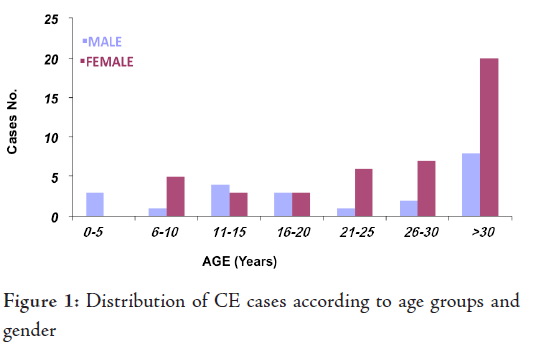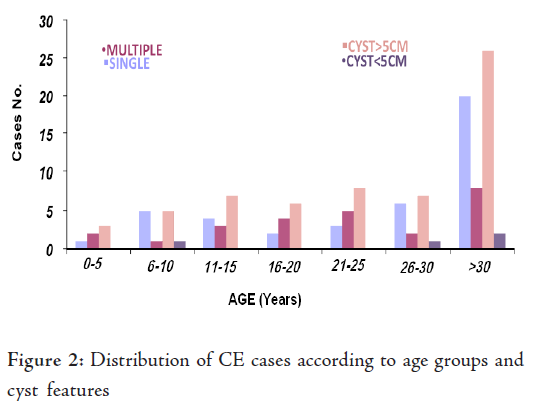Hydatid Disease in Yemeni Patients attending Public and Private Hospitals in Sana’a City, Yemen
Abdulbasit Alghoury, Eman El-Hamshary, Ahmed Azazy, Eman Hussein, Hanan Z. Rayan
Alghoury A, et al. OMJ. 25, 88-90 (2010); doi:10.5001/omj.2010.26
ABSTRACT
Objectives: Hydatid disease is endemic and represents a major health problem in Yemen. The aim of this study is to determine the magnitude of the problem of hydatidosis in patients attending Public and Private Hospitals at Sana’a city, Yemen.
Methods:66 patients with hydatid disease were identified during the period from August 2006 to February 2007. Complete medical history for all CE patients were collected and analyzed.
Results: Among the 66 CE patients, 67% were females and 33% males. Liver was the most common involved organ. Single cyst was more frequently detected than multiple cysts and approximately 94% of the cysts were ≥5 cm. Moreover, Public hospitals were the main source of patients with CE disease.
Conclusion: Hydatidosis is still an endemic disease and an important health problem in Yemen which needs to be studied further. Therefore, accurate information on the distribution of the disease is the first step for the control and prevention of the disease. Moreover, it is crucial to investigate the role of different intermediate hosts and genotypes of E. granulosus in humans and animals.
From the Department of Medical Parasitology, Faculty of Medicine and Health Sciences, Sana’a University, Sana’a, Yemen.
Received: 18 Jan 2010
Accepted: 03 Mar 2010
Address correspondence and reprint requests to: Dr. Abdulbasit Alghoury, Department of Medical Parasitology, Faculty of Medicine and Health Sciences, Sana’a University, Sana’a, Yemen.
E-mail: basit_alghoury@yahoo.com
Alghoury A, et al. OMJ. 25, 88-90 (2010); doi:10.5001/omj.2010.26
INTRODUCTIONS
Hydatidosis or Cystic echinococcosis (CE ) is an important zoonotic disease that constitutes a major public health problem in many countries around the world.1 The disease is concentrated in the sheep-raising and pastoral areas. Although hydatid disease has been entirely eradicated in some countries, it remains a serious endemic health problem in certain parts of the world such as the Middle east, Mediterranean area, South America and Australia. 2.3
In Yemen, hydatid disease is still endemic and hepatic hydatid cyst represents a major health problem.4,5 This study aims to detemine the magnitude of the problem of CE in patients attending Public and Private Hospitals at Sana’a city, Yemen
METHODSYemeni hospitals both public and private in Sana’a city attract patients from all over the country. In this descriptive study, complete medical history of all CE patients were collected and analyzed.
The study included patients attending the outpatient and inpatient departments of surgery at Yemeni public and private hospitals in Sana’a city.
CE patients were diagnosed by various imaging techniques, including US, CT, X-ray and MRI for a period of seven months between August 2006 and February 2007. Detection and removal of the cysts through operation as well as microscopic examination of the aspirated hydatid fluid were confirmatory. The ethics committee approved the study and informed consent was obtained from all participants.
RESULTSA total of 66 CE patients were identified. They include 22 males (33%) and 44 females (67%) aged between 5 years to >30 years. The majority of the patients were >30 years old (40.4%) and public hospitals had a higher proportion of infected people (79%) than private hospitals which accounted for only 21%. (Fig. 1)
The features of the cysts (site, number and size) were identified and are presented in Table 1 and Fig. 2. With regards to the number of cysts, 40 patients (61%) had a single cyst in each effected organ while 26 patients (39%) had multiple cysts (Fig. 2). Cysts less than 5 cm were demonstrated among 4 patients (6%), while cysts greater than 5 cm were detected in 62 patients (94%). (Fig. 2)
In terms of the site of the cysts and the affected organs, the results showed that, 38 patients (57.6%) had isolated hepatic hydatid cysts, while 17 patients (25.8%) had isolated pulmonary hydatid cysts. Only three patients (4.5%) had combined affected organ. The remaining 8 patients had hydatid cysts in the ovary (2 patients), kidney (2 patients), uterus (2 patients), brain (1 patient) and iliac fossa (1 patient).
Table 1 shows that the most common affected site in the liver was the right hepatic lobe (65.78%). In the lung, the right lobe was markedly affected (58.8%) than the left lobe (1.1%).
Cystic Echinococcosis/hydatidosis is one of the most important zoonotic diseases in the world. High parasite prevalence is found in the Middle East as well as Arabic North Africa.6 In Yemen, hydatidosis is still endemic and amazingly more prevalent in females than males, while hepatic cysts represent a major health problem.4.5.7 A Survey study of the endoparasites of stray dogs in Sana’a, Yemen showed that 57% of stray dogs were infected with intestinal parasites especially E. granulosus and the incidence of infection was 7.1%.7
In this present study, infected females (67%) were double the number of infected males (33%). This finding is in agreement with other studies conducted in Yemen, which reported that females were more exposed to echinococcal infection than males.4,7 Additionally, in Morocco and Libya, as well as in China, it was reported that females were more exposed to echinococcal infection than males.8,9,10 On the contrary in Kyrgyzstan, it was reported that males were more exposed to the infection than females.11 The differences in reports could be attributed to the difference in socio-economic and cultural status from country to country. It is not surprising in the Yemeni community since a considerable proportion of females continue to have some activities related to animal breeding and/or agriculture.
In the present study, the age of the majority of identified patients was more than 30 years old (40.4%). Only three patients were 5 years old, two of whom had isolated pulmonary CE and one had isolated hepatopulmonary CE. Several studies have demonstrated that CE sparked medical attention in almost all ages, from below one year to over 75 years of age, and the pattern of gradual increase in prevalence of CE with age is very general and has been observed in many endemic countries.9,10,12,13
The majority of patients in the present study were found in the public hospitals (79%), this could be attributed to the fact that public hospitals have good facilities with sufficient equipment and staff.
It was observed that the most common affected organ was the liver (57.58%), followed by the lung (25.75%). The higher rate of hepatic infection may be attributed to the fact that the liver acts as the primary filter in the human body and the lung is often thought to be the second filter.14 A similar picture of organ affection to this has been reported by other studies. It was reported that the most frequent site of hydatid cysts was the liver (50-70%) followed by the lung (20-30%) and less frequently, kidney, heart, bones and elsewhere.10,15,16,17
In the present study, 40 patients (61%) had single cyst in each affected organ while 26 patients (39%) demonstrated multiple cysts. In addition, 4 patients (6%) had cysts sized less than 5 cm, while 62 patients (94%) had cysts sized greater than 5 cm. These findings are in accordance with other studies published which reported that the most common ultrasonographic features of hydatid cysts are their spherical shape and the fact that they are unilocular.18,19 The results showed that the less common features were either a multicystic appearance, having a detached germinal layer or evidence of hydatid sand within the cyst.12,18,19 The predominance of solitary and single organ involvement over multiple organ involvement was noted in the present study. In this respect, it is widely accepted that primary cysts are mostly solitary in nature.20 However, in the present study, it was difficult to ascertain whether multiple cysts are primary or secondary.
CONCLUSIONIn conclusion, Hydatid disease is still an important health problem in Yemen which needs to be studied further. Therefore, accurate information on the distribution of the disease should be the first step for the control and prevention of the disease. Moreover, it is necessary to investigate the role of different intermediate hosts and the strains of E .granulosus in humans and animals in each province.
We are very grateful to all staff of the Surgery and Radiological Departments in all Yemeni hospitals at Sana?a city for their kind assistance and valuable information. The authors reported no conflict of interest and funding was received on this work.
-
Morar R, Feldman C. Pulmonary echinococcosis. Eur Respir J. 2003; 21: 1069-1077.
-
Erman T, Tuna M, Gocer I, Ildan F, Zeren M. and Centinalp E. Intracranial intraosseous hydatid cyst. Neurosurg Focus. 2001; 11: 1-3.
-
McManus DP, Zhang W, Li J, Bartley PB. Echinococcosis. Lancet. 2003; 18(362):1295-304.
-
AL-Hureibi AA, Amer A, Al-Hureibi MA, Sharawee Z. Hepatic hydatid cysts: Presentation surgical management in Yemen. JR Coll Surg Edinb.1992; 37:229-321.
-
Azazy AA, Abdel-Hamid AH. Indirect haemagglutination (IHA) for the diagnosis of hydatid disease in Yemen. J Egypt Soc Parasitol. 2000; 30:407-411.
-
Sadjjadi S.M. Present situation of echinococcosis in the Middle East and Arabic North Africa. Parasitol Int.2006; 55:S197-202.
-
Saif WN. Survey of the endoparasites of stray dogs in Sana’a- republic of Yemen. Sana’a University, Faculty of Science, MSc Thesis. 2001.
-
El-idrissi LA, Mahjour J, Ayoujil M, Barkia A. Retrospective survey for surgical cases of cystic Echinococcosis in Morocco (1980-1992)., In: Andersen FL, Ouhelli H, Kachani M, editors. Compendium on cystic Echinococcosis Brigham Young University, print Services. Provo, USA. 1997; 194-206.
-
Shambesh MA, Craig PS, Macpherson CN, Rogan MT, Gusbi AM, Echtuish EF. An extensive ultrasound and serologic study to investigate the prevalence of human cystic echinococcosis in northern Libya. Am J Trop Med Hyg. 1999; 60(3): 462-468.
-
Pawlowski ZS, Eckert J, Vuitton DA, Ammann RW, Kern P, Craig PS, et al. Echinococcosis in humans: Clinical aspects, diagnosis and treatment. In: Eckert J, Gemmell MA, Meslin FX, Pawlowski ZS, editors. Manual on Echinococcus in Humans and Animals a public health problem of global concern. WHO. Paris, France. 2001; 20-66.
-
Togerson PR, Karaeva RR, Corkeri N, Abdyjaparov TA, Kuttubaev OT. Human cystic echinococcosis in Kyrgystan: an epidemiological study. Acta Tropica, 2003; 85: 51-61.
-
Carmona C, Perdomo R, Carbo A, Alvarez C, Monti J, Grauert R, et al. Risk factors associated with human cystic echinococcosis in Florida, Uruguay: Results of a mass screening study using ultrasound and serology. Am J Trop Med Hyg. 1998; 58: 599-605.
-
Wang YH, Rogan MT, Vuitton DA, Wen H, Bartholomot B, Macpherson CN, et al. Cystic echinococcosis in semi-nomadic pastoral communities in North-West China. Trans R Soc Trop Med Hyg. 2001; 95(2):153-158.
-
Muller R, Director F, Wakelin D. Worms and human disease. 2nd ed. London UK, CABI Publishing. 2002.
-
Schantz PM, Gottstein R. Echinococcosis (Hydatidosis). In: Wall KW, Schantz PM, editors. Immunodiagnosis of parasitic diseases. Academic press, Orland Fl. 1986; 1:69-107.
-
Taori K, Sanyal R, Mahajan S, Jajoo G, Saxena V, Bhagat M. CT appearances of hydatid disease at various locations. Australasian radiology. 2006; 50:298-305.
-
Fatimi SH, Naureen S, Moizuddin SS, Puri MM, Yousuf MA, Javed MA, et al. Pulmonary hydatidosis: clinical profile and follow up from an endemic region. ANZ J Surg. 2007; 77:749-51.
-
Niron A, Ozer H. Ultarsound appearance of liver hydatid disease. Brit J Rad. 1981; 54:335-338.
-
Kanat F, Turk E, Aribas OK. Comparison of pulmonary hydatid cysts in children and adults. ANZJ Surg. 2004; 74:885-889.
-
Al-Barwari SE, Saeed IS, Khalid W, Al-Harmni KI. Human hydatidosis in Arbil, N. Iraq. Journal of Islamic Academy of Sciences. 1991; 4(4):330-335.


